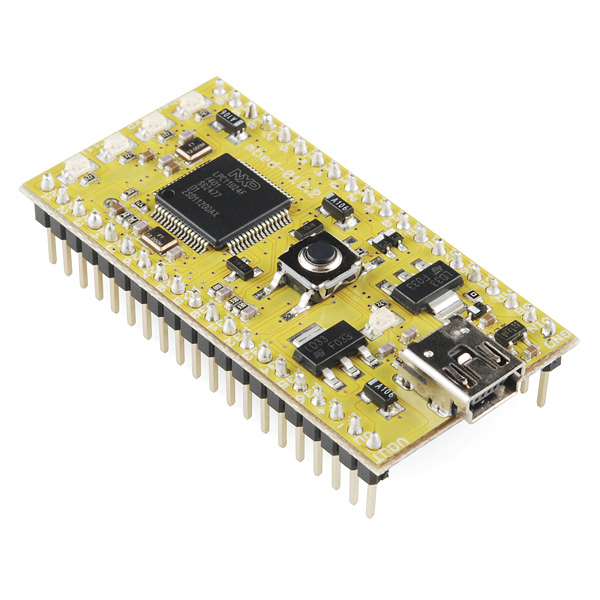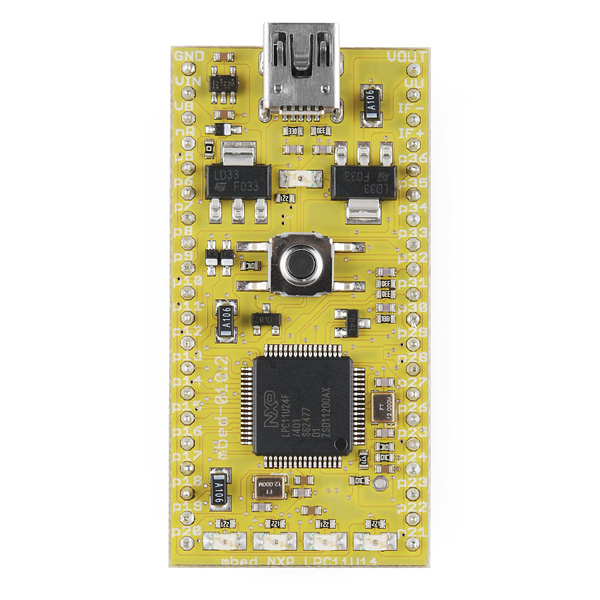mbed - LPC11U24 (Cortex-M0)
Replacement: None. We are no longer carrying the LPC11U24 in our catalog. This page is for reference only.
The mbed microcontrollers are a series of ARM microcontroller development boards designed for rapid prototyping and this is the latest in a line of big things in small packages. Specifically designed for prototyping low cost USB devices and battery powered applications, the mbed NXP LPC11U24 microcontroller is a bite-sized platform for 32-bit ARM® Cortex™-M0 based designs.
The DIP form-factor makes this board ideal for prototyping on breadboards, stripboards or through-hole PCBs. The board even includes a built-in USB Flash programmer. The mbed microcontrollers provide experienced embedded developers a powerful and productive platform for building proof-of-concepts. For developers new to 32-bit microcontrollers, mbed provides an accessible prototyping solution to get projects built with the backing of libraries, resources and support shared in the mbed community. There's even a lightweight online compiler available so that you can develop and share your code online!
- mbed NXP LPC11U24 microcontroller
- 6' USB Mini-B Cable
- Setup Guide
- mbed Sticker!
- Low power ARM® Cortex™-M0 Core
- 48MHz, 8KB RAM, 32KB FLASH
- USB Device, 2xSPI, I2C , UART, 6xADC, GPIO
- 40-pin 0.1" pitch DIP package
- 5V USB, 4.5-9V supply or 2.4-3.3V battery
- Built-in USB drag 'n' drop FLASH programmer
- Lightweight Online Compiler
- High level C/C++ SDK
- Cookbook of published libraries and projects
- 54 x 26mm
mbed - LPC11U24 (Cortex-M0) Product Help and Resources
Core Skill: Programming
If a board needs code or communicates somehow, you're going to need to know how to program or interface with it. The programming skill is all about communication and code.
Skill Level: Competent - The toolchain for programming is a bit more complex and will examples may not be explicitly provided for you. You will be required to have a fundamental knowledge of programming and be required to provide your own code. You may need to modify existing libraries or code to work with your specific hardware. Sensor and hardware interfaces will be SPI or I2C.
See all skill levels
Core Skill: Electrical Prototyping
If it requires power, you need to know how much, what all the pins do, and how to hook it up. You may need to reference datasheets, schematics, and know the ins and outs of electronics.
Skill Level: Noob - You don't need to reference a datasheet, but you will need to know basic power requirements.
See all skill levels
Comments
Looking for answers to technical questions?
We welcome your comments and suggestions below. However, if you are looking for solutions to technical questions please see our Technical Assistance page.
Customer Reviews
No reviews yet.





They just announced a basic RTOS that works on mbed using the online compiler. Just compiled and ran the demo to blink two LEDs using two threads. You don't have to use it unless you need it. Add the RTOS library to your project and one include line in your C/C++ to use it.
http://mbed.org/handbook/RTOS
It does take a fair chunk of memory for the RTOS. The other mbed module (M3) has more memory, networking, and is faster, but this one takes less power.
I wonder why this was retired. I was all set to buy this board here, but ended up buying it from Mouser instead.
The LPCXpresso Board for LPC11C24 » OM13012 is about $20...
One of the pictures, between the no-ruler top, and the USB cable, is missing. Guessing this is the bottom view? "View Source" says that the URL is:
which obviously doesn't return anything of use; that's the folder where all the images are stored. I think this should be something like http://dlnmh9ip6v2uc.cloudfront.net/images/products/11045-03_i_th.jpg. (Access denied; the picture is there but the permissions are wrong?)
Judging from the schematic, the bottom view would be similar to the other mbed with the large 'mbed interface' IC and a serial Flash storage chip. The bottom of the other mbed is here: http://dlnmh9ip6v2uc.cloudfront.net/images/products/09564-03.jpg. This one wouldn't have the large-ish QFN at the top; that's the Ethernet MAC.
That "Access Denied" error doesn't necessarily mean the image is there: it just means that any nonexistent images in that directory are restricted.